Education and Training: Behaviour Management and Assessment Analysis
VerifiedAdded on 2023/01/12
|21
|7846
|1
Report
AI Summary
This report delves into the core concepts of education and training, offering a comprehensive analysis of behaviour management, assessment methodologies, and communication theories. It begins by examining pedagogical principles and theories of behaviour management, emphasizing their role in evaluating the effectiveness of creative and innovative teaching approaches. The report then explores the significance and practical application of initial and diagnostic assessments, focusing on aligning individual learning goals with student needs. Furthermore, it provides a detailed discussion of diverse communication theories and their impact on the learning process, enriching the understanding of effective teaching strategies. The report also includes practical examples and analyses of different assessment types, considering their effectiveness in meeting the diverse needs of learners, drawing on research and observations from teaching practice. Overall, the report aims to provide educators with insights and tools for enhancing their teaching practices and creating more effective learning environments.
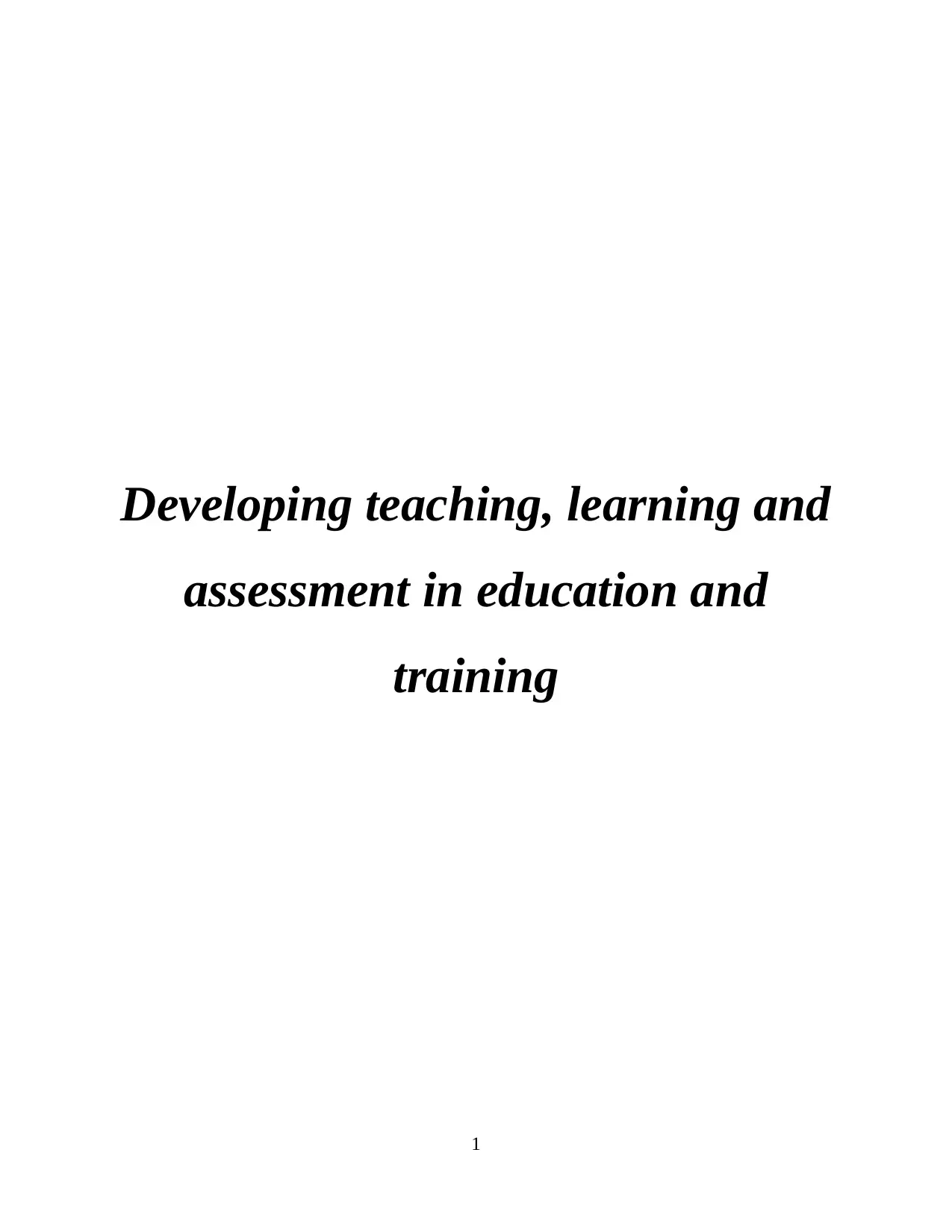
Developing teaching, learning and
assessment in education and
training
1
assessment in education and
training
1
Paraphrase This Document
Need a fresh take? Get an instant paraphrase of this document with our AI Paraphraser
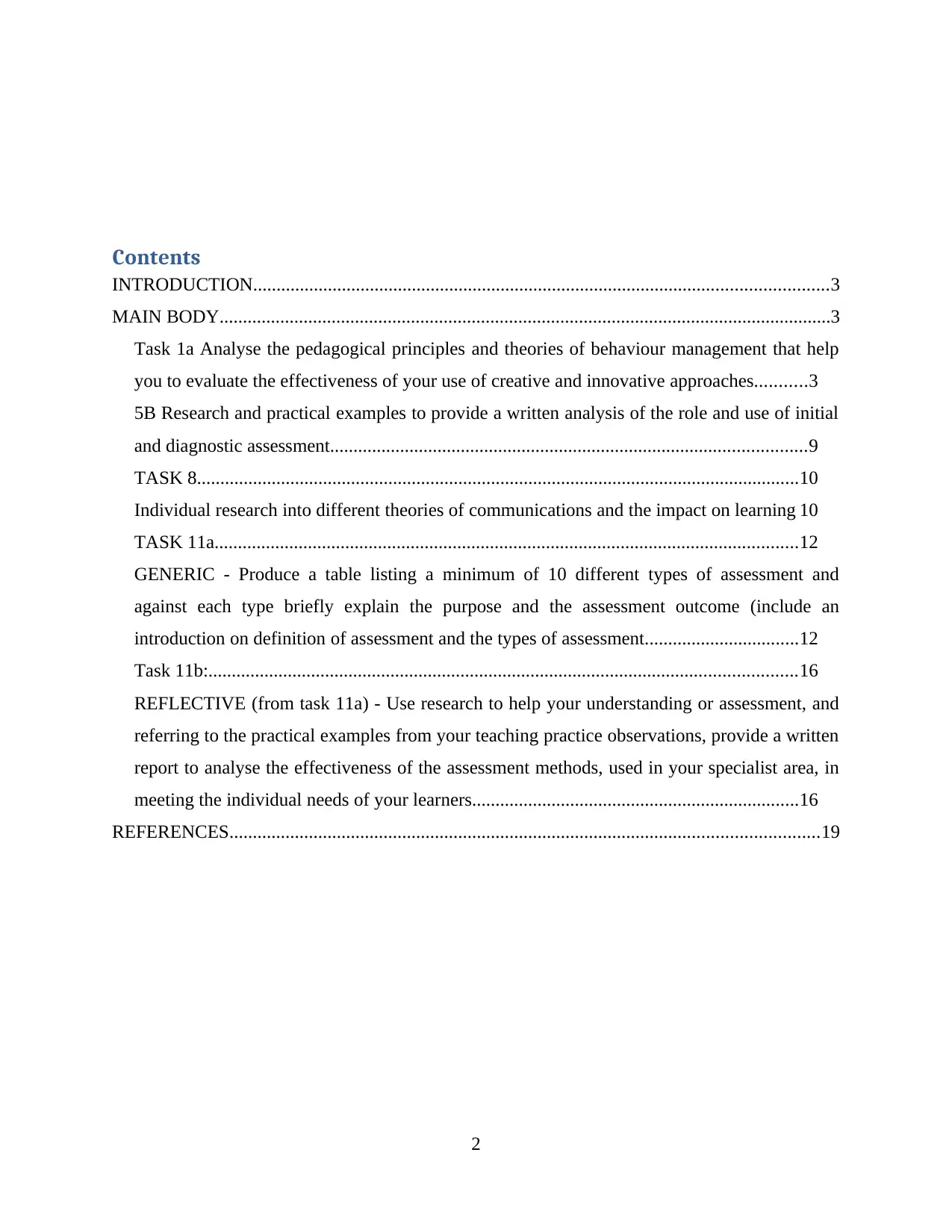
Contents
INTRODUCTION...........................................................................................................................3
MAIN BODY...................................................................................................................................3
Task 1a Analyse the pedagogical principles and theories of behaviour management that help
you to evaluate the effectiveness of your use of creative and innovative approaches...........3
5B Research and practical examples to provide a written analysis of the role and use of initial
and diagnostic assessment......................................................................................................9
TASK 8.................................................................................................................................10
Individual research into different theories of communications and the impact on learning 10
TASK 11a.............................................................................................................................12
GENERIC - Produce a table listing a minimum of 10 different types of assessment and
against each type briefly explain the purpose and the assessment outcome (include an
introduction on definition of assessment and the types of assessment.................................12
Task 11b:..............................................................................................................................16
REFLECTIVE (from task 11a) - Use research to help your understanding or assessment, and
referring to the practical examples from your teaching practice observations, provide a written
report to analyse the effectiveness of the assessment methods, used in your specialist area, in
meeting the individual needs of your learners......................................................................16
REFERENCES..............................................................................................................................19
2
INTRODUCTION...........................................................................................................................3
MAIN BODY...................................................................................................................................3
Task 1a Analyse the pedagogical principles and theories of behaviour management that help
you to evaluate the effectiveness of your use of creative and innovative approaches...........3
5B Research and practical examples to provide a written analysis of the role and use of initial
and diagnostic assessment......................................................................................................9
TASK 8.................................................................................................................................10
Individual research into different theories of communications and the impact on learning 10
TASK 11a.............................................................................................................................12
GENERIC - Produce a table listing a minimum of 10 different types of assessment and
against each type briefly explain the purpose and the assessment outcome (include an
introduction on definition of assessment and the types of assessment.................................12
Task 11b:..............................................................................................................................16
REFLECTIVE (from task 11a) - Use research to help your understanding or assessment, and
referring to the practical examples from your teaching practice observations, provide a written
report to analyse the effectiveness of the assessment methods, used in your specialist area, in
meeting the individual needs of your learners......................................................................16
REFERENCES..............................................................................................................................19
2
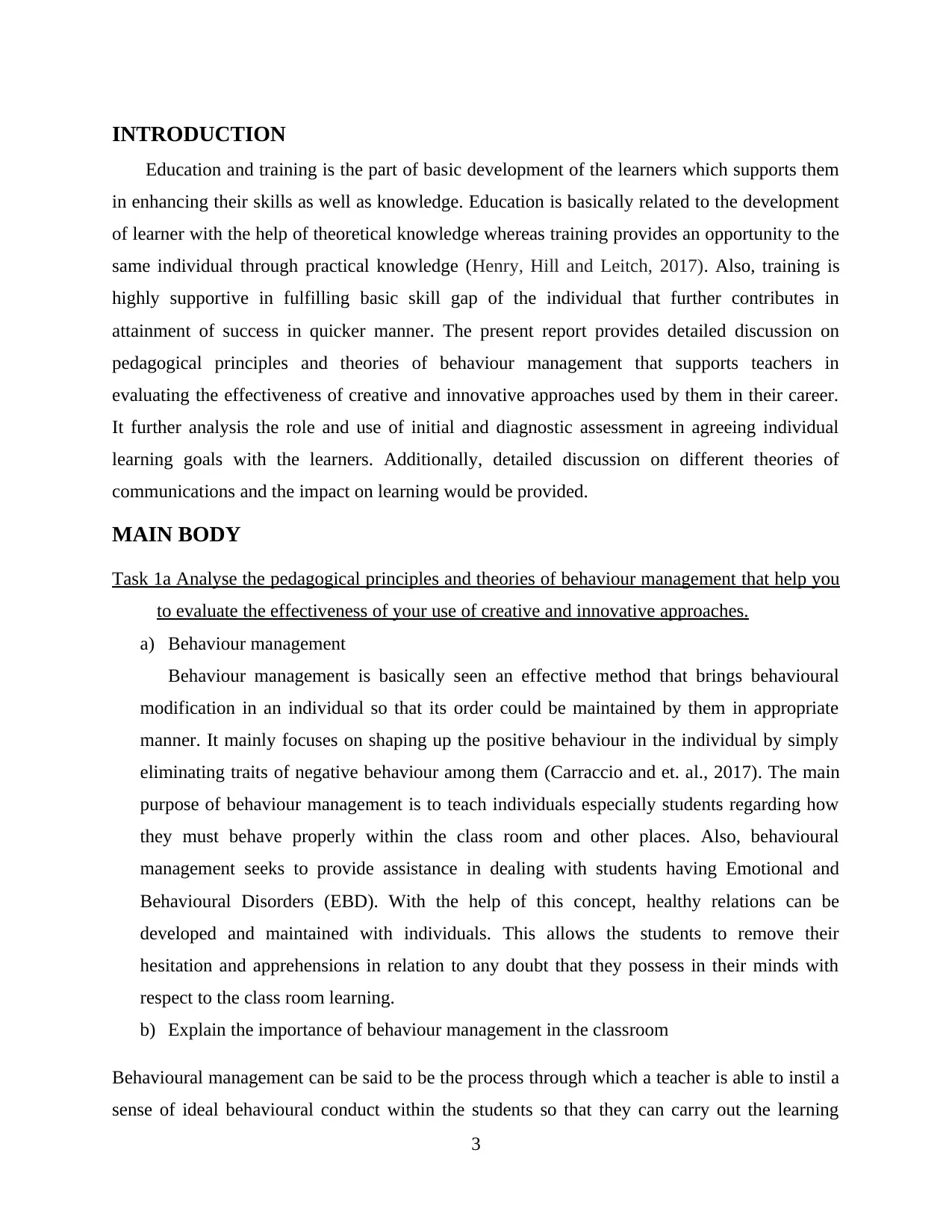
INTRODUCTION
Education and training is the part of basic development of the learners which supports them
in enhancing their skills as well as knowledge. Education is basically related to the development
of learner with the help of theoretical knowledge whereas training provides an opportunity to the
same individual through practical knowledge (Henry, Hill and Leitch, 2017). Also, training is
highly supportive in fulfilling basic skill gap of the individual that further contributes in
attainment of success in quicker manner. The present report provides detailed discussion on
pedagogical principles and theories of behaviour management that supports teachers in
evaluating the effectiveness of creative and innovative approaches used by them in their career.
It further analysis the role and use of initial and diagnostic assessment in agreeing individual
learning goals with the learners. Additionally, detailed discussion on different theories of
communications and the impact on learning would be provided.
MAIN BODY
Task 1a Analyse the pedagogical principles and theories of behaviour management that help you
to evaluate the effectiveness of your use of creative and innovative approaches.
a) Behaviour management
Behaviour management is basically seen an effective method that brings behavioural
modification in an individual so that its order could be maintained by them in appropriate
manner. It mainly focuses on shaping up the positive behaviour in the individual by simply
eliminating traits of negative behaviour among them (Carraccio and et. al., 2017). The main
purpose of behaviour management is to teach individuals especially students regarding how
they must behave properly within the class room and other places. Also, behavioural
management seeks to provide assistance in dealing with students having Emotional and
Behavioural Disorders (EBD). With the help of this concept, healthy relations can be
developed and maintained with individuals. This allows the students to remove their
hesitation and apprehensions in relation to any doubt that they possess in their minds with
respect to the class room learning.
b) Explain the importance of behaviour management in the classroom
Behavioural management can be said to be the process through which a teacher is able to instil a
sense of ideal behavioural conduct within the students so that they can carry out the learning
3
Education and training is the part of basic development of the learners which supports them
in enhancing their skills as well as knowledge. Education is basically related to the development
of learner with the help of theoretical knowledge whereas training provides an opportunity to the
same individual through practical knowledge (Henry, Hill and Leitch, 2017). Also, training is
highly supportive in fulfilling basic skill gap of the individual that further contributes in
attainment of success in quicker manner. The present report provides detailed discussion on
pedagogical principles and theories of behaviour management that supports teachers in
evaluating the effectiveness of creative and innovative approaches used by them in their career.
It further analysis the role and use of initial and diagnostic assessment in agreeing individual
learning goals with the learners. Additionally, detailed discussion on different theories of
communications and the impact on learning would be provided.
MAIN BODY
Task 1a Analyse the pedagogical principles and theories of behaviour management that help you
to evaluate the effectiveness of your use of creative and innovative approaches.
a) Behaviour management
Behaviour management is basically seen an effective method that brings behavioural
modification in an individual so that its order could be maintained by them in appropriate
manner. It mainly focuses on shaping up the positive behaviour in the individual by simply
eliminating traits of negative behaviour among them (Carraccio and et. al., 2017). The main
purpose of behaviour management is to teach individuals especially students regarding how
they must behave properly within the class room and other places. Also, behavioural
management seeks to provide assistance in dealing with students having Emotional and
Behavioural Disorders (EBD). With the help of this concept, healthy relations can be
developed and maintained with individuals. This allows the students to remove their
hesitation and apprehensions in relation to any doubt that they possess in their minds with
respect to the class room learning.
b) Explain the importance of behaviour management in the classroom
Behavioural management can be said to be the process through which a teacher is able to instil a
sense of ideal behavioural conduct within the students so that they can carry out the learning
3
⊘ This is a preview!⊘
Do you want full access?
Subscribe today to unlock all pages.

Trusted by 1+ million students worldwide
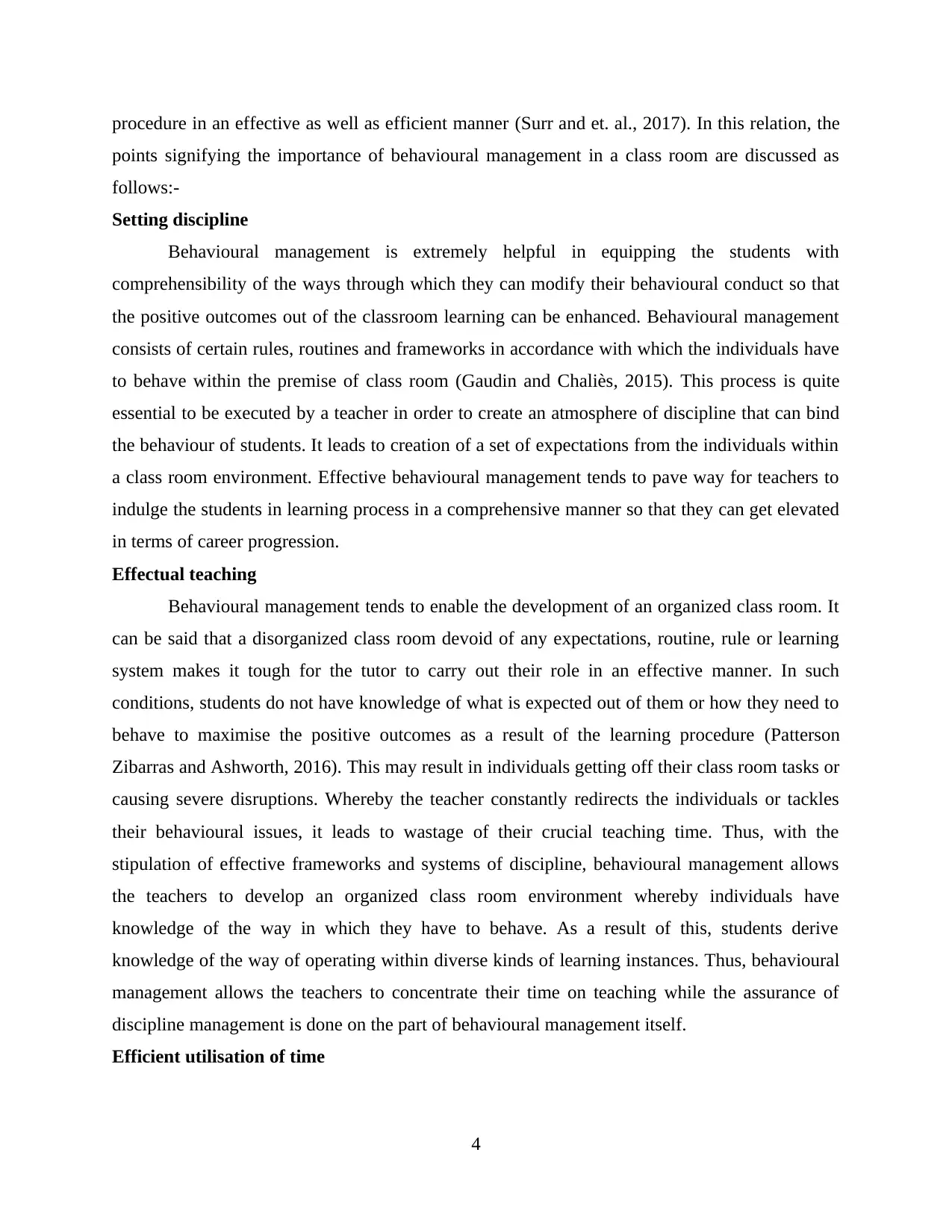
procedure in an effective as well as efficient manner (Surr and et. al., 2017). In this relation, the
points signifying the importance of behavioural management in a class room are discussed as
follows:-
Setting discipline
Behavioural management is extremely helpful in equipping the students with
comprehensibility of the ways through which they can modify their behavioural conduct so that
the positive outcomes out of the classroom learning can be enhanced. Behavioural management
consists of certain rules, routines and frameworks in accordance with which the individuals have
to behave within the premise of class room (Gaudin and Chaliès, 2015). This process is quite
essential to be executed by a teacher in order to create an atmosphere of discipline that can bind
the behaviour of students. It leads to creation of a set of expectations from the individuals within
a class room environment. Effective behavioural management tends to pave way for teachers to
indulge the students in learning process in a comprehensive manner so that they can get elevated
in terms of career progression.
Effectual teaching
Behavioural management tends to enable the development of an organized class room. It
can be said that a disorganized class room devoid of any expectations, routine, rule or learning
system makes it tough for the tutor to carry out their role in an effective manner. In such
conditions, students do not have knowledge of what is expected out of them or how they need to
behave to maximise the positive outcomes as a result of the learning procedure (Patterson
Zibarras and Ashworth, 2016). This may result in individuals getting off their class room tasks or
causing severe disruptions. Whereby the teacher constantly redirects the individuals or tackles
their behavioural issues, it leads to wastage of their crucial teaching time. Thus, with the
stipulation of effective frameworks and systems of discipline, behavioural management allows
the teachers to develop an organized class room environment whereby individuals have
knowledge of the way in which they have to behave. As a result of this, students derive
knowledge of the way of operating within diverse kinds of learning instances. Thus, behavioural
management allows the teachers to concentrate their time on teaching while the assurance of
discipline management is done on the part of behavioural management itself.
Efficient utilisation of time
4
points signifying the importance of behavioural management in a class room are discussed as
follows:-
Setting discipline
Behavioural management is extremely helpful in equipping the students with
comprehensibility of the ways through which they can modify their behavioural conduct so that
the positive outcomes out of the classroom learning can be enhanced. Behavioural management
consists of certain rules, routines and frameworks in accordance with which the individuals have
to behave within the premise of class room (Gaudin and Chaliès, 2015). This process is quite
essential to be executed by a teacher in order to create an atmosphere of discipline that can bind
the behaviour of students. It leads to creation of a set of expectations from the individuals within
a class room environment. Effective behavioural management tends to pave way for teachers to
indulge the students in learning process in a comprehensive manner so that they can get elevated
in terms of career progression.
Effectual teaching
Behavioural management tends to enable the development of an organized class room. It
can be said that a disorganized class room devoid of any expectations, routine, rule or learning
system makes it tough for the tutor to carry out their role in an effective manner. In such
conditions, students do not have knowledge of what is expected out of them or how they need to
behave to maximise the positive outcomes as a result of the learning procedure (Patterson
Zibarras and Ashworth, 2016). This may result in individuals getting off their class room tasks or
causing severe disruptions. Whereby the teacher constantly redirects the individuals or tackles
their behavioural issues, it leads to wastage of their crucial teaching time. Thus, with the
stipulation of effective frameworks and systems of discipline, behavioural management allows
the teachers to develop an organized class room environment whereby individuals have
knowledge of the way in which they have to behave. As a result of this, students derive
knowledge of the way of operating within diverse kinds of learning instances. Thus, behavioural
management allows the teachers to concentrate their time on teaching while the assurance of
discipline management is done on the part of behavioural management itself.
Efficient utilisation of time
4
Paraphrase This Document
Need a fresh take? Get an instant paraphrase of this document with our AI Paraphraser
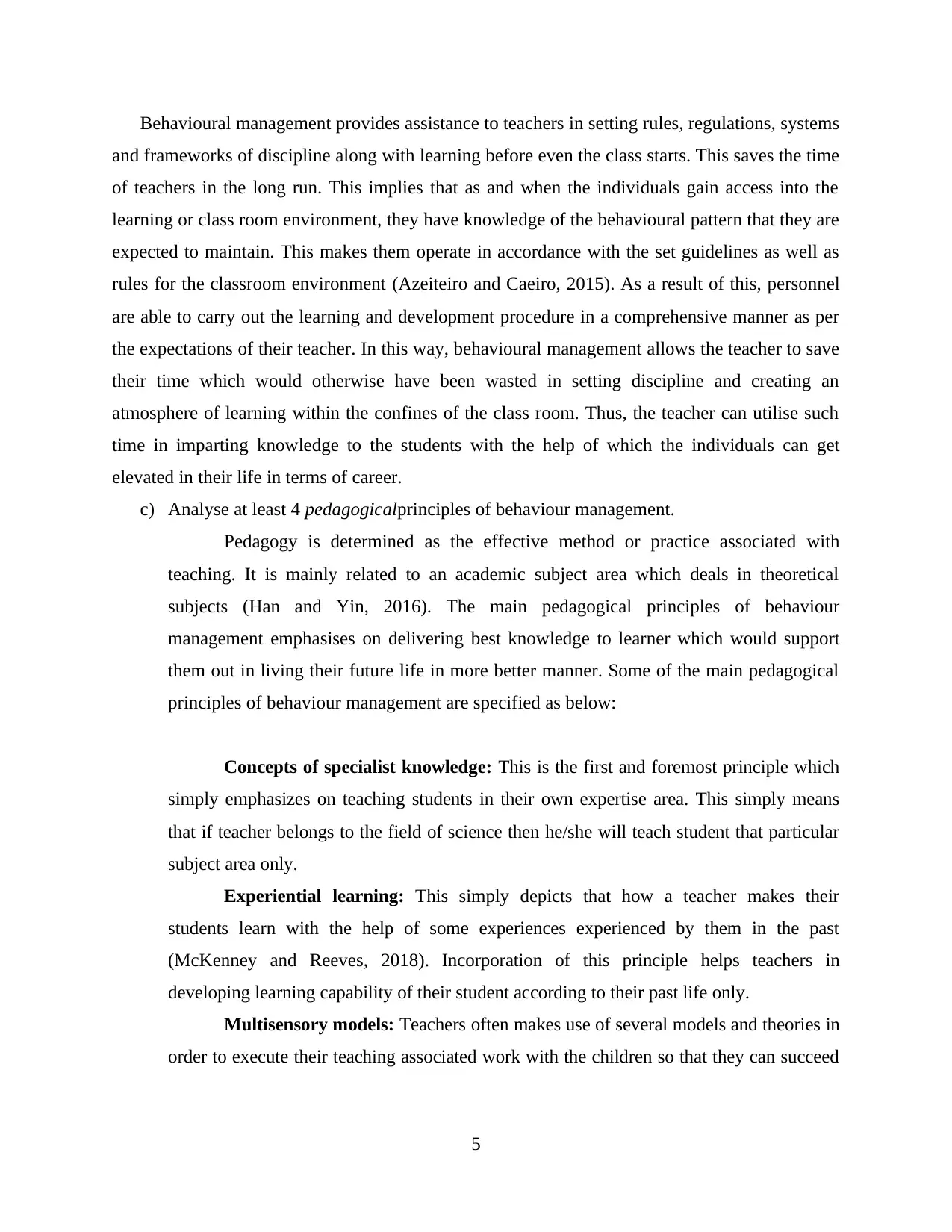
Behavioural management provides assistance to teachers in setting rules, regulations, systems
and frameworks of discipline along with learning before even the class starts. This saves the time
of teachers in the long run. This implies that as and when the individuals gain access into the
learning or class room environment, they have knowledge of the behavioural pattern that they are
expected to maintain. This makes them operate in accordance with the set guidelines as well as
rules for the classroom environment (Azeiteiro and Caeiro, 2015). As a result of this, personnel
are able to carry out the learning and development procedure in a comprehensive manner as per
the expectations of their teacher. In this way, behavioural management allows the teacher to save
their time which would otherwise have been wasted in setting discipline and creating an
atmosphere of learning within the confines of the class room. Thus, the teacher can utilise such
time in imparting knowledge to the students with the help of which the individuals can get
elevated in their life in terms of career.
c) Analyse at least 4 pedagogicalprinciples of behaviour management.
Pedagogy is determined as the effective method or practice associated with
teaching. It is mainly related to an academic subject area which deals in theoretical
subjects (Han and Yin, 2016). The main pedagogical principles of behaviour
management emphasises on delivering best knowledge to learner which would support
them out in living their future life in more better manner. Some of the main pedagogical
principles of behaviour management are specified as below:
Concepts of specialist knowledge: This is the first and foremost principle which
simply emphasizes on teaching students in their own expertise area. This simply means
that if teacher belongs to the field of science then he/she will teach student that particular
subject area only.
Experiential learning: This simply depicts that how a teacher makes their
students learn with the help of some experiences experienced by them in the past
(McKenney and Reeves, 2018). Incorporation of this principle helps teachers in
developing learning capability of their student according to their past life only.
Multisensory models: Teachers often makes use of several models and theories in
order to execute their teaching associated work with the children so that they can succeed
5
and frameworks of discipline along with learning before even the class starts. This saves the time
of teachers in the long run. This implies that as and when the individuals gain access into the
learning or class room environment, they have knowledge of the behavioural pattern that they are
expected to maintain. This makes them operate in accordance with the set guidelines as well as
rules for the classroom environment (Azeiteiro and Caeiro, 2015). As a result of this, personnel
are able to carry out the learning and development procedure in a comprehensive manner as per
the expectations of their teacher. In this way, behavioural management allows the teacher to save
their time which would otherwise have been wasted in setting discipline and creating an
atmosphere of learning within the confines of the class room. Thus, the teacher can utilise such
time in imparting knowledge to the students with the help of which the individuals can get
elevated in their life in terms of career.
c) Analyse at least 4 pedagogicalprinciples of behaviour management.
Pedagogy is determined as the effective method or practice associated with
teaching. It is mainly related to an academic subject area which deals in theoretical
subjects (Han and Yin, 2016). The main pedagogical principles of behaviour
management emphasises on delivering best knowledge to learner which would support
them out in living their future life in more better manner. Some of the main pedagogical
principles of behaviour management are specified as below:
Concepts of specialist knowledge: This is the first and foremost principle which
simply emphasizes on teaching students in their own expertise area. This simply means
that if teacher belongs to the field of science then he/she will teach student that particular
subject area only.
Experiential learning: This simply depicts that how a teacher makes their
students learn with the help of some experiences experienced by them in the past
(McKenney and Reeves, 2018). Incorporation of this principle helps teachers in
developing learning capability of their student according to their past life only.
Multisensory models: Teachers often makes use of several models and theories in
order to execute their teaching associated work with the children so that they can succeed
5
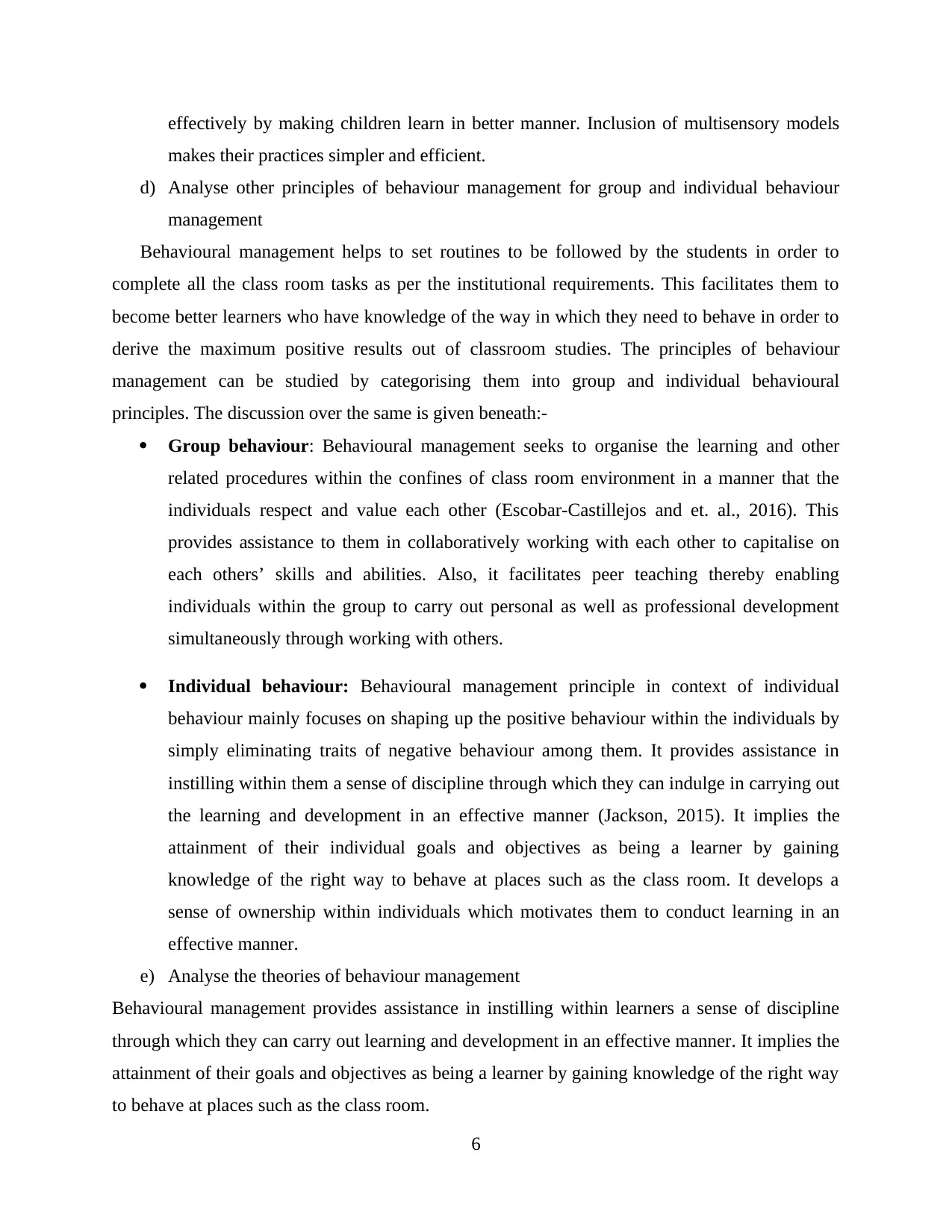
effectively by making children learn in better manner. Inclusion of multisensory models
makes their practices simpler and efficient.
d) Analyse other principles of behaviour management for group and individual behaviour
management
Behavioural management helps to set routines to be followed by the students in order to
complete all the class room tasks as per the institutional requirements. This facilitates them to
become better learners who have knowledge of the way in which they need to behave in order to
derive the maximum positive results out of classroom studies. The principles of behaviour
management can be studied by categorising them into group and individual behavioural
principles. The discussion over the same is given beneath:-
Group behaviour: Behavioural management seeks to organise the learning and other
related procedures within the confines of class room environment in a manner that the
individuals respect and value each other (Escobar-Castillejos and et. al., 2016). This
provides assistance to them in collaboratively working with each other to capitalise on
each others’ skills and abilities. Also, it facilitates peer teaching thereby enabling
individuals within the group to carry out personal as well as professional development
simultaneously through working with others.
Individual behaviour: Behavioural management principle in context of individual
behaviour mainly focuses on shaping up the positive behaviour within the individuals by
simply eliminating traits of negative behaviour among them. It provides assistance in
instilling within them a sense of discipline through which they can indulge in carrying out
the learning and development in an effective manner (Jackson, 2015). It implies the
attainment of their individual goals and objectives as being a learner by gaining
knowledge of the right way to behave at places such as the class room. It develops a
sense of ownership within individuals which motivates them to conduct learning in an
effective manner.
e) Analyse the theories of behaviour management
Behavioural management provides assistance in instilling within learners a sense of discipline
through which they can carry out learning and development in an effective manner. It implies the
attainment of their goals and objectives as being a learner by gaining knowledge of the right way
to behave at places such as the class room.
6
makes their practices simpler and efficient.
d) Analyse other principles of behaviour management for group and individual behaviour
management
Behavioural management helps to set routines to be followed by the students in order to
complete all the class room tasks as per the institutional requirements. This facilitates them to
become better learners who have knowledge of the way in which they need to behave in order to
derive the maximum positive results out of classroom studies. The principles of behaviour
management can be studied by categorising them into group and individual behavioural
principles. The discussion over the same is given beneath:-
Group behaviour: Behavioural management seeks to organise the learning and other
related procedures within the confines of class room environment in a manner that the
individuals respect and value each other (Escobar-Castillejos and et. al., 2016). This
provides assistance to them in collaboratively working with each other to capitalise on
each others’ skills and abilities. Also, it facilitates peer teaching thereby enabling
individuals within the group to carry out personal as well as professional development
simultaneously through working with others.
Individual behaviour: Behavioural management principle in context of individual
behaviour mainly focuses on shaping up the positive behaviour within the individuals by
simply eliminating traits of negative behaviour among them. It provides assistance in
instilling within them a sense of discipline through which they can indulge in carrying out
the learning and development in an effective manner (Jackson, 2015). It implies the
attainment of their individual goals and objectives as being a learner by gaining
knowledge of the right way to behave at places such as the class room. It develops a
sense of ownership within individuals which motivates them to conduct learning in an
effective manner.
e) Analyse the theories of behaviour management
Behavioural management provides assistance in instilling within learners a sense of discipline
through which they can carry out learning and development in an effective manner. It implies the
attainment of their goals and objectives as being a learner by gaining knowledge of the right way
to behave at places such as the class room.
6
⊘ This is a preview!⊘
Do you want full access?
Subscribe today to unlock all pages.

Trusted by 1+ million students worldwide
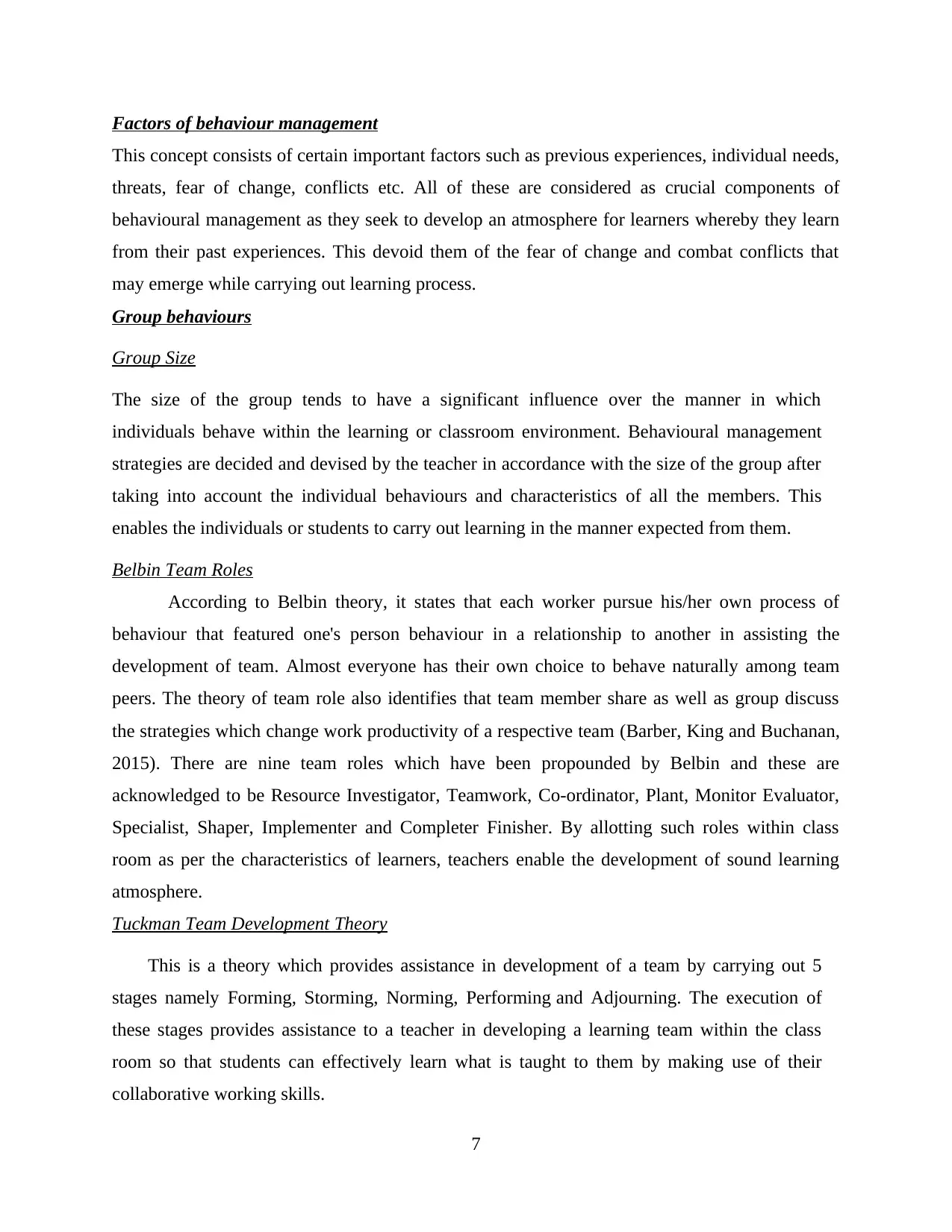
Factors of behaviour management
This concept consists of certain important factors such as previous experiences, individual needs,
threats, fear of change, conflicts etc. All of these are considered as crucial components of
behavioural management as they seek to develop an atmosphere for learners whereby they learn
from their past experiences. This devoid them of the fear of change and combat conflicts that
may emerge while carrying out learning process.
Group behaviours
Group Size
The size of the group tends to have a significant influence over the manner in which
individuals behave within the learning or classroom environment. Behavioural management
strategies are decided and devised by the teacher in accordance with the size of the group after
taking into account the individual behaviours and characteristics of all the members. This
enables the individuals or students to carry out learning in the manner expected from them.
Belbin Team Roles
According to Belbin theory, it states that each worker pursue his/her own process of
behaviour that featured one's person behaviour in a relationship to another in assisting the
development of team. Almost everyone has their own choice to behave naturally among team
peers. The theory of team role also identifies that team member share as well as group discuss
the strategies which change work productivity of a respective team (Barber, King and Buchanan,
2015). There are nine team roles which have been propounded by Belbin and these are
acknowledged to be Resource Investigator, Teamwork, Co-ordinator, Plant, Monitor Evaluator,
Specialist, Shaper, Implementer and Completer Finisher. By allotting such roles within class
room as per the characteristics of learners, teachers enable the development of sound learning
atmosphere.
Tuckman Team Development Theory
This is a theory which provides assistance in development of a team by carrying out 5
stages namely Forming, Storming, Norming, Performing and Adjourning. The execution of
these stages provides assistance to a teacher in developing a learning team within the class
room so that students can effectively learn what is taught to them by making use of their
collaborative working skills.
7
This concept consists of certain important factors such as previous experiences, individual needs,
threats, fear of change, conflicts etc. All of these are considered as crucial components of
behavioural management as they seek to develop an atmosphere for learners whereby they learn
from their past experiences. This devoid them of the fear of change and combat conflicts that
may emerge while carrying out learning process.
Group behaviours
Group Size
The size of the group tends to have a significant influence over the manner in which
individuals behave within the learning or classroom environment. Behavioural management
strategies are decided and devised by the teacher in accordance with the size of the group after
taking into account the individual behaviours and characteristics of all the members. This
enables the individuals or students to carry out learning in the manner expected from them.
Belbin Team Roles
According to Belbin theory, it states that each worker pursue his/her own process of
behaviour that featured one's person behaviour in a relationship to another in assisting the
development of team. Almost everyone has their own choice to behave naturally among team
peers. The theory of team role also identifies that team member share as well as group discuss
the strategies which change work productivity of a respective team (Barber, King and Buchanan,
2015). There are nine team roles which have been propounded by Belbin and these are
acknowledged to be Resource Investigator, Teamwork, Co-ordinator, Plant, Monitor Evaluator,
Specialist, Shaper, Implementer and Completer Finisher. By allotting such roles within class
room as per the characteristics of learners, teachers enable the development of sound learning
atmosphere.
Tuckman Team Development Theory
This is a theory which provides assistance in development of a team by carrying out 5
stages namely Forming, Storming, Norming, Performing and Adjourning. The execution of
these stages provides assistance to a teacher in developing a learning team within the class
room so that students can effectively learn what is taught to them by making use of their
collaborative working skills.
7
Paraphrase This Document
Need a fresh take? Get an instant paraphrase of this document with our AI Paraphraser
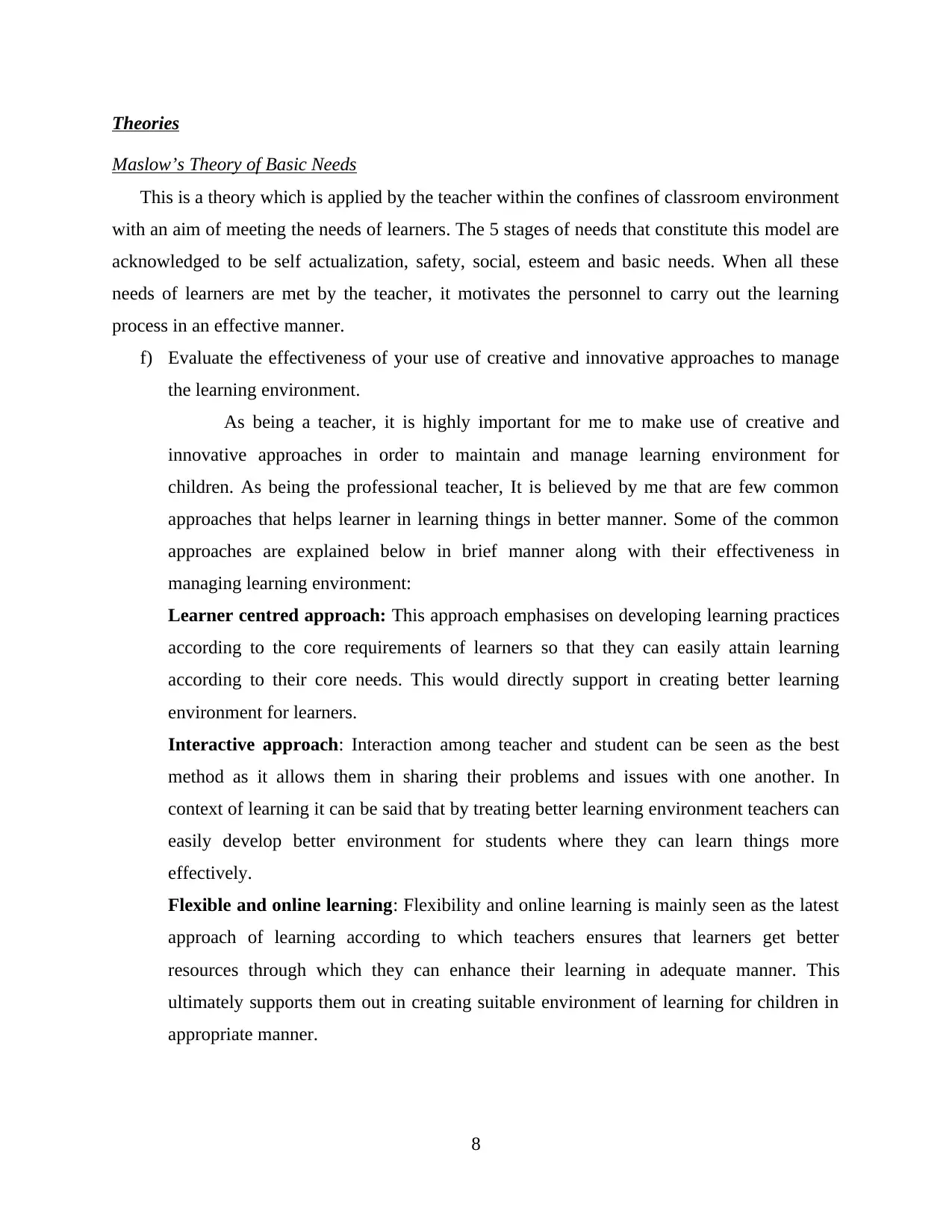
Theories
Maslow’s Theory of Basic Needs
This is a theory which is applied by the teacher within the confines of classroom environment
with an aim of meeting the needs of learners. The 5 stages of needs that constitute this model are
acknowledged to be self actualization, safety, social, esteem and basic needs. When all these
needs of learners are met by the teacher, it motivates the personnel to carry out the learning
process in an effective manner.
f) Evaluate the effectiveness of your use of creative and innovative approaches to manage
the learning environment.
As being a teacher, it is highly important for me to make use of creative and
innovative approaches in order to maintain and manage learning environment for
children. As being the professional teacher, It is believed by me that are few common
approaches that helps learner in learning things in better manner. Some of the common
approaches are explained below in brief manner along with their effectiveness in
managing learning environment:
Learner centred approach: This approach emphasises on developing learning practices
according to the core requirements of learners so that they can easily attain learning
according to their core needs. This would directly support in creating better learning
environment for learners.
Interactive approach: Interaction among teacher and student can be seen as the best
method as it allows them in sharing their problems and issues with one another. In
context of learning it can be said that by treating better learning environment teachers can
easily develop better environment for students where they can learn things more
effectively.
Flexible and online learning: Flexibility and online learning is mainly seen as the latest
approach of learning according to which teachers ensures that learners get better
resources through which they can enhance their learning in adequate manner. This
ultimately supports them out in creating suitable environment of learning for children in
appropriate manner.
8
Maslow’s Theory of Basic Needs
This is a theory which is applied by the teacher within the confines of classroom environment
with an aim of meeting the needs of learners. The 5 stages of needs that constitute this model are
acknowledged to be self actualization, safety, social, esteem and basic needs. When all these
needs of learners are met by the teacher, it motivates the personnel to carry out the learning
process in an effective manner.
f) Evaluate the effectiveness of your use of creative and innovative approaches to manage
the learning environment.
As being a teacher, it is highly important for me to make use of creative and
innovative approaches in order to maintain and manage learning environment for
children. As being the professional teacher, It is believed by me that are few common
approaches that helps learner in learning things in better manner. Some of the common
approaches are explained below in brief manner along with their effectiveness in
managing learning environment:
Learner centred approach: This approach emphasises on developing learning practices
according to the core requirements of learners so that they can easily attain learning
according to their core needs. This would directly support in creating better learning
environment for learners.
Interactive approach: Interaction among teacher and student can be seen as the best
method as it allows them in sharing their problems and issues with one another. In
context of learning it can be said that by treating better learning environment teachers can
easily develop better environment for students where they can learn things more
effectively.
Flexible and online learning: Flexibility and online learning is mainly seen as the latest
approach of learning according to which teachers ensures that learners get better
resources through which they can enhance their learning in adequate manner. This
ultimately supports them out in creating suitable environment of learning for children in
appropriate manner.
8
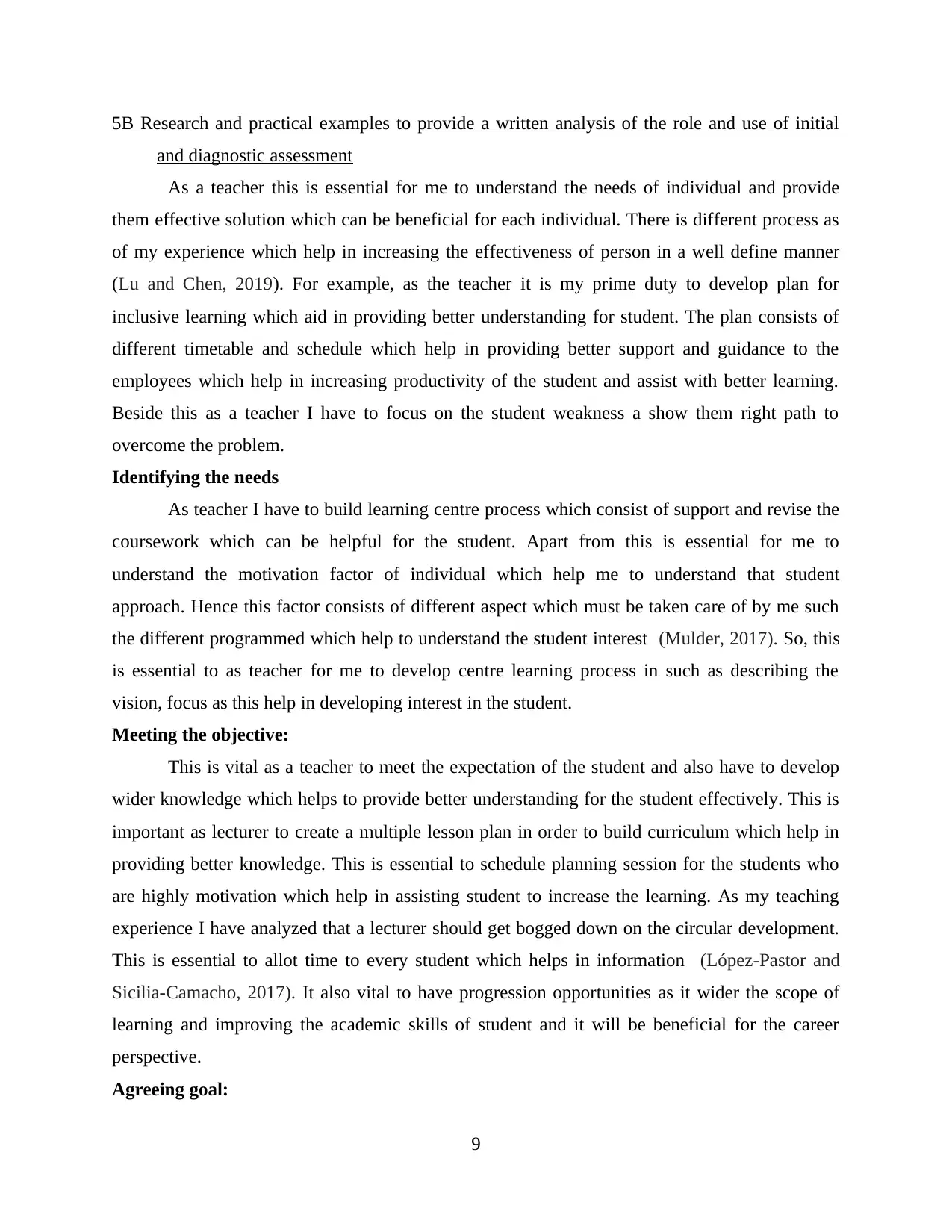
5B Research and practical examples to provide a written analysis of the role and use of initial
and diagnostic assessment
As a teacher this is essential for me to understand the needs of individual and provide
them effective solution which can be beneficial for each individual. There is different process as
of my experience which help in increasing the effectiveness of person in a well define manner
(Lu and Chen, 2019). For example, as the teacher it is my prime duty to develop plan for
inclusive learning which aid in providing better understanding for student. The plan consists of
different timetable and schedule which help in providing better support and guidance to the
employees which help in increasing productivity of the student and assist with better learning.
Beside this as a teacher I have to focus on the student weakness a show them right path to
overcome the problem.
Identifying the needs
As teacher I have to build learning centre process which consist of support and revise the
coursework which can be helpful for the student. Apart from this is essential for me to
understand the motivation factor of individual which help me to understand that student
approach. Hence this factor consists of different aspect which must be taken care of by me such
the different programmed which help to understand the student interest (Mulder, 2017). So, this
is essential to as teacher for me to develop centre learning process in such as describing the
vision, focus as this help in developing interest in the student.
Meeting the objective:
This is vital as a teacher to meet the expectation of the student and also have to develop
wider knowledge which helps to provide better understanding for the student effectively. This is
important as lecturer to create a multiple lesson plan in order to build curriculum which help in
providing better knowledge. This is essential to schedule planning session for the students who
are highly motivation which help in assisting student to increase the learning. As my teaching
experience I have analyzed that a lecturer should get bogged down on the circular development.
This is essential to allot time to every student which helps in information (López-Pastor and
Sicilia-Camacho, 2017). It also vital to have progression opportunities as it wider the scope of
learning and improving the academic skills of student and it will be beneficial for the career
perspective.
Agreeing goal:
9
and diagnostic assessment
As a teacher this is essential for me to understand the needs of individual and provide
them effective solution which can be beneficial for each individual. There is different process as
of my experience which help in increasing the effectiveness of person in a well define manner
(Lu and Chen, 2019). For example, as the teacher it is my prime duty to develop plan for
inclusive learning which aid in providing better understanding for student. The plan consists of
different timetable and schedule which help in providing better support and guidance to the
employees which help in increasing productivity of the student and assist with better learning.
Beside this as a teacher I have to focus on the student weakness a show them right path to
overcome the problem.
Identifying the needs
As teacher I have to build learning centre process which consist of support and revise the
coursework which can be helpful for the student. Apart from this is essential for me to
understand the motivation factor of individual which help me to understand that student
approach. Hence this factor consists of different aspect which must be taken care of by me such
the different programmed which help to understand the student interest (Mulder, 2017). So, this
is essential to as teacher for me to develop centre learning process in such as describing the
vision, focus as this help in developing interest in the student.
Meeting the objective:
This is vital as a teacher to meet the expectation of the student and also have to develop
wider knowledge which helps to provide better understanding for the student effectively. This is
important as lecturer to create a multiple lesson plan in order to build curriculum which help in
providing better knowledge. This is essential to schedule planning session for the students who
are highly motivation which help in assisting student to increase the learning. As my teaching
experience I have analyzed that a lecturer should get bogged down on the circular development.
This is essential to allot time to every student which helps in information (López-Pastor and
Sicilia-Camacho, 2017). It also vital to have progression opportunities as it wider the scope of
learning and improving the academic skills of student and it will be beneficial for the career
perspective.
Agreeing goal:
9
⊘ This is a preview!⊘
Do you want full access?
Subscribe today to unlock all pages.

Trusted by 1+ million students worldwide
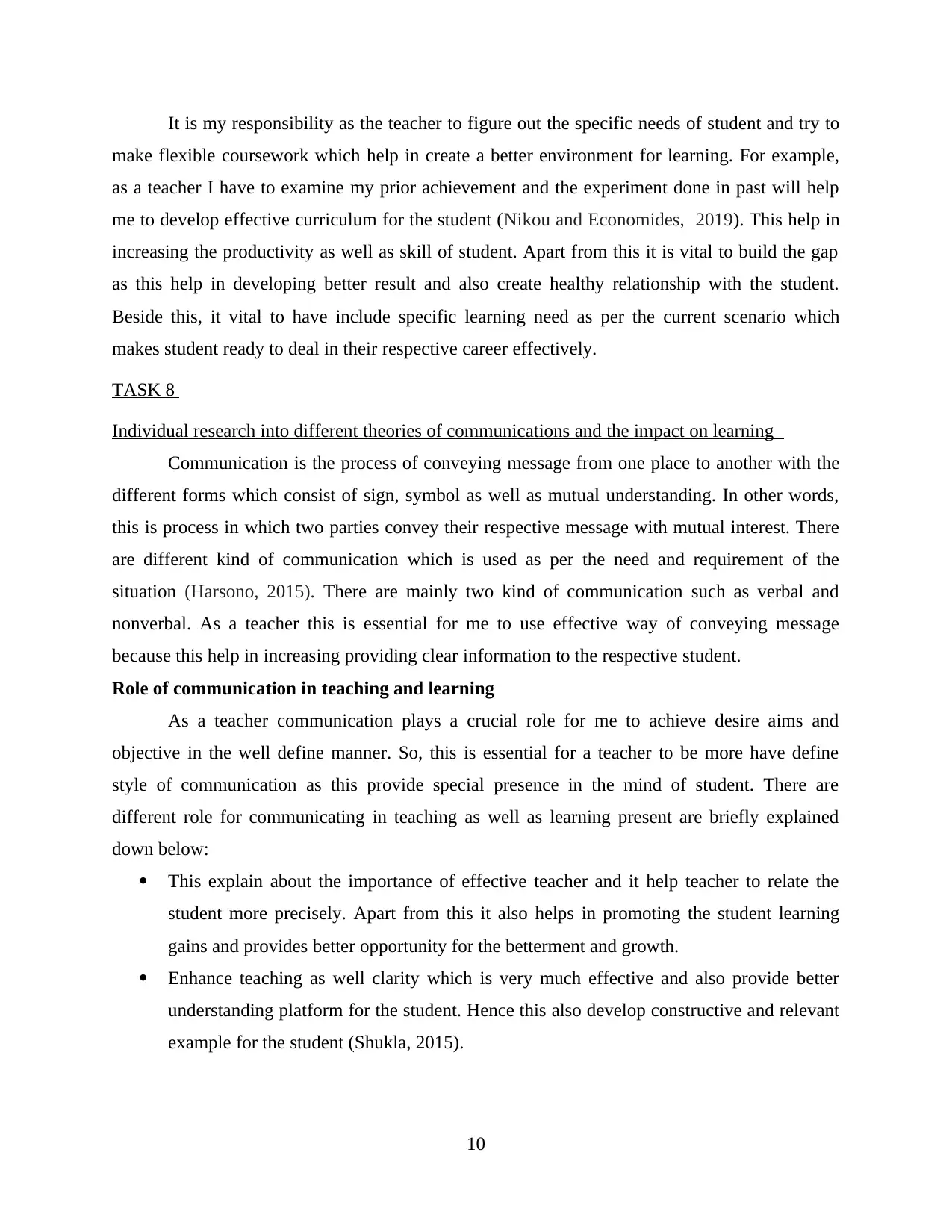
It is my responsibility as the teacher to figure out the specific needs of student and try to
make flexible coursework which help in create a better environment for learning. For example,
as a teacher I have to examine my prior achievement and the experiment done in past will help
me to develop effective curriculum for the student (Nikou and Economides, 2019). This help in
increasing the productivity as well as skill of student. Apart from this it is vital to build the gap
as this help in developing better result and also create healthy relationship with the student.
Beside this, it vital to have include specific learning need as per the current scenario which
makes student ready to deal in their respective career effectively.
TASK 8
Individual research into different theories of communications and the impact on learning
Communication is the process of conveying message from one place to another with the
different forms which consist of sign, symbol as well as mutual understanding. In other words,
this is process in which two parties convey their respective message with mutual interest. There
are different kind of communication which is used as per the need and requirement of the
situation (Harsono, 2015). There are mainly two kind of communication such as verbal and
nonverbal. As a teacher this is essential for me to use effective way of conveying message
because this help in increasing providing clear information to the respective student.
Role of communication in teaching and learning
As a teacher communication plays a crucial role for me to achieve desire aims and
objective in the well define manner. So, this is essential for a teacher to be more have define
style of communication as this provide special presence in the mind of student. There are
different role for communicating in teaching as well as learning present are briefly explained
down below:
This explain about the importance of effective teacher and it help teacher to relate the
student more precisely. Apart from this it also helps in promoting the student learning
gains and provides better opportunity for the betterment and growth.
Enhance teaching as well clarity which is very much effective and also provide better
understanding platform for the student. Hence this also develop constructive and relevant
example for the student (Shukla, 2015).
10
make flexible coursework which help in create a better environment for learning. For example,
as a teacher I have to examine my prior achievement and the experiment done in past will help
me to develop effective curriculum for the student (Nikou and Economides, 2019). This help in
increasing the productivity as well as skill of student. Apart from this it is vital to build the gap
as this help in developing better result and also create healthy relationship with the student.
Beside this, it vital to have include specific learning need as per the current scenario which
makes student ready to deal in their respective career effectively.
TASK 8
Individual research into different theories of communications and the impact on learning
Communication is the process of conveying message from one place to another with the
different forms which consist of sign, symbol as well as mutual understanding. In other words,
this is process in which two parties convey their respective message with mutual interest. There
are different kind of communication which is used as per the need and requirement of the
situation (Harsono, 2015). There are mainly two kind of communication such as verbal and
nonverbal. As a teacher this is essential for me to use effective way of conveying message
because this help in increasing providing clear information to the respective student.
Role of communication in teaching and learning
As a teacher communication plays a crucial role for me to achieve desire aims and
objective in the well define manner. So, this is essential for a teacher to be more have define
style of communication as this provide special presence in the mind of student. There are
different role for communicating in teaching as well as learning present are briefly explained
down below:
This explain about the importance of effective teacher and it help teacher to relate the
student more precisely. Apart from this it also helps in promoting the student learning
gains and provides better opportunity for the betterment and growth.
Enhance teaching as well clarity which is very much effective and also provide better
understanding platform for the student. Hence this also develop constructive and relevant
example for the student (Shukla, 2015).
10
Paraphrase This Document
Need a fresh take? Get an instant paraphrase of this document with our AI Paraphraser
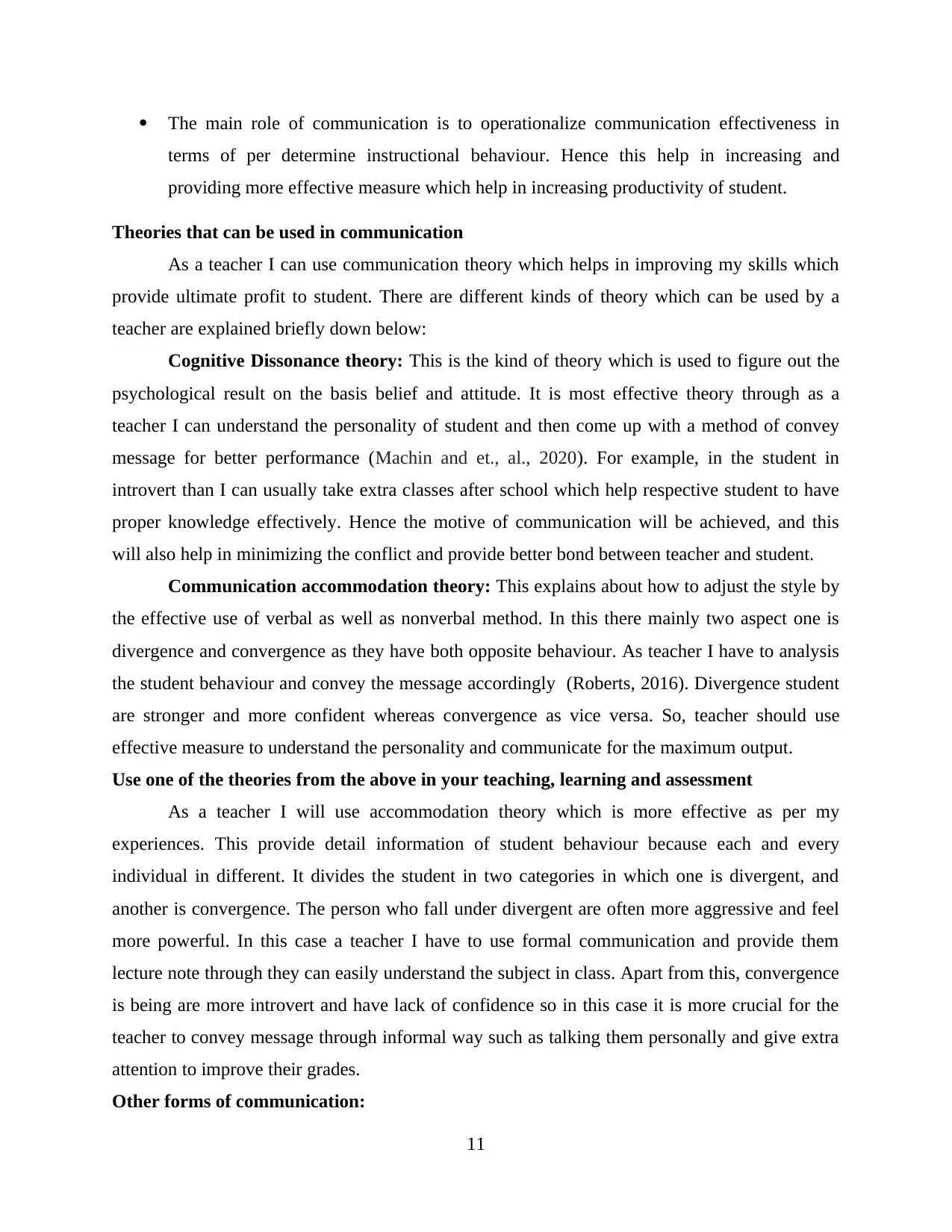
The main role of communication is to operationalize communication effectiveness in
terms of per determine instructional behaviour. Hence this help in increasing and
providing more effective measure which help in increasing productivity of student.
Theories that can be used in communication
As a teacher I can use communication theory which helps in improving my skills which
provide ultimate profit to student. There are different kinds of theory which can be used by a
teacher are explained briefly down below:
Cognitive Dissonance theory: This is the kind of theory which is used to figure out the
psychological result on the basis belief and attitude. It is most effective theory through as a
teacher I can understand the personality of student and then come up with a method of convey
message for better performance (Machin and et., al., 2020). For example, in the student in
introvert than I can usually take extra classes after school which help respective student to have
proper knowledge effectively. Hence the motive of communication will be achieved, and this
will also help in minimizing the conflict and provide better bond between teacher and student.
Communication accommodation theory: This explains about how to adjust the style by
the effective use of verbal as well as nonverbal method. In this there mainly two aspect one is
divergence and convergence as they have both opposite behaviour. As teacher I have to analysis
the student behaviour and convey the message accordingly (Roberts, 2016). Divergence student
are stronger and more confident whereas convergence as vice versa. So, teacher should use
effective measure to understand the personality and communicate for the maximum output.
Use one of the theories from the above in your teaching, learning and assessment
As a teacher I will use accommodation theory which is more effective as per my
experiences. This provide detail information of student behaviour because each and every
individual in different. It divides the student in two categories in which one is divergent, and
another is convergence. The person who fall under divergent are often more aggressive and feel
more powerful. In this case a teacher I have to use formal communication and provide them
lecture note through they can easily understand the subject in class. Apart from this, convergence
is being are more introvert and have lack of confidence so in this case it is more crucial for the
teacher to convey message through informal way such as talking them personally and give extra
attention to improve their grades.
Other forms of communication:
11
terms of per determine instructional behaviour. Hence this help in increasing and
providing more effective measure which help in increasing productivity of student.
Theories that can be used in communication
As a teacher I can use communication theory which helps in improving my skills which
provide ultimate profit to student. There are different kinds of theory which can be used by a
teacher are explained briefly down below:
Cognitive Dissonance theory: This is the kind of theory which is used to figure out the
psychological result on the basis belief and attitude. It is most effective theory through as a
teacher I can understand the personality of student and then come up with a method of convey
message for better performance (Machin and et., al., 2020). For example, in the student in
introvert than I can usually take extra classes after school which help respective student to have
proper knowledge effectively. Hence the motive of communication will be achieved, and this
will also help in minimizing the conflict and provide better bond between teacher and student.
Communication accommodation theory: This explains about how to adjust the style by
the effective use of verbal as well as nonverbal method. In this there mainly two aspect one is
divergence and convergence as they have both opposite behaviour. As teacher I have to analysis
the student behaviour and convey the message accordingly (Roberts, 2016). Divergence student
are stronger and more confident whereas convergence as vice versa. So, teacher should use
effective measure to understand the personality and communicate for the maximum output.
Use one of the theories from the above in your teaching, learning and assessment
As a teacher I will use accommodation theory which is more effective as per my
experiences. This provide detail information of student behaviour because each and every
individual in different. It divides the student in two categories in which one is divergent, and
another is convergence. The person who fall under divergent are often more aggressive and feel
more powerful. In this case a teacher I have to use formal communication and provide them
lecture note through they can easily understand the subject in class. Apart from this, convergence
is being are more introvert and have lack of confidence so in this case it is more crucial for the
teacher to convey message through informal way such as talking them personally and give extra
attention to improve their grades.
Other forms of communication:
11
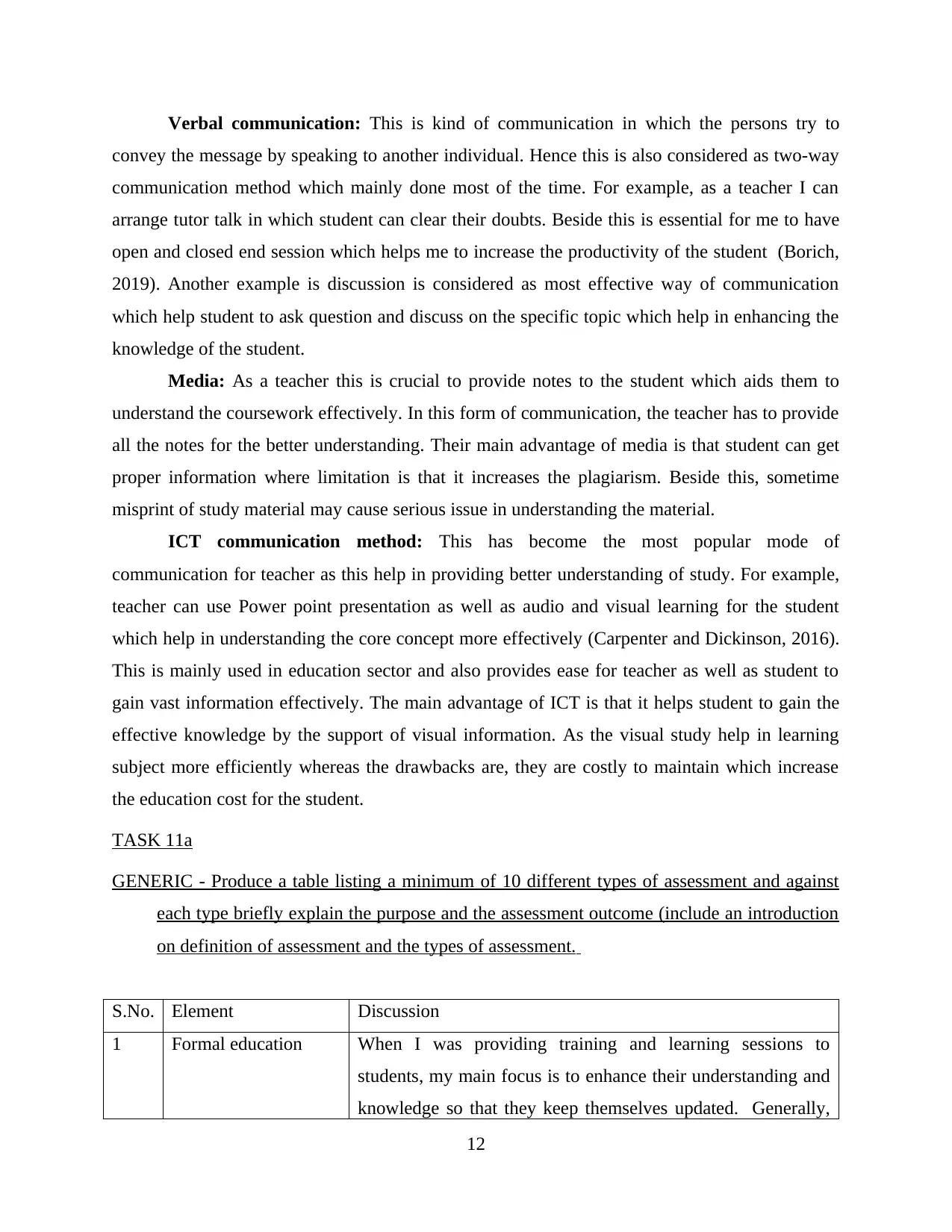
Verbal communication: This is kind of communication in which the persons try to
convey the message by speaking to another individual. Hence this is also considered as two-way
communication method which mainly done most of the time. For example, as a teacher I can
arrange tutor talk in which student can clear their doubts. Beside this is essential for me to have
open and closed end session which helps me to increase the productivity of the student (Borich,
2019). Another example is discussion is considered as most effective way of communication
which help student to ask question and discuss on the specific topic which help in enhancing the
knowledge of the student.
Media: As a teacher this is crucial to provide notes to the student which aids them to
understand the coursework effectively. In this form of communication, the teacher has to provide
all the notes for the better understanding. Their main advantage of media is that student can get
proper information where limitation is that it increases the plagiarism. Beside this, sometime
misprint of study material may cause serious issue in understanding the material.
ICT communication method: This has become the most popular mode of
communication for teacher as this help in providing better understanding of study. For example,
teacher can use Power point presentation as well as audio and visual learning for the student
which help in understanding the core concept more effectively (Carpenter and Dickinson, 2016).
This is mainly used in education sector and also provides ease for teacher as well as student to
gain vast information effectively. The main advantage of ICT is that it helps student to gain the
effective knowledge by the support of visual information. As the visual study help in learning
subject more efficiently whereas the drawbacks are, they are costly to maintain which increase
the education cost for the student.
TASK 11a
GENERIC - Produce a table listing a minimum of 10 different types of assessment and against
each type briefly explain the purpose and the assessment outcome (include an introduction
on definition of assessment and the types of assessment.
S.No. Element Discussion
1 Formal education When I was providing training and learning sessions to
students, my main focus is to enhance their understanding and
knowledge so that they keep themselves updated. Generally,
12
convey the message by speaking to another individual. Hence this is also considered as two-way
communication method which mainly done most of the time. For example, as a teacher I can
arrange tutor talk in which student can clear their doubts. Beside this is essential for me to have
open and closed end session which helps me to increase the productivity of the student (Borich,
2019). Another example is discussion is considered as most effective way of communication
which help student to ask question and discuss on the specific topic which help in enhancing the
knowledge of the student.
Media: As a teacher this is crucial to provide notes to the student which aids them to
understand the coursework effectively. In this form of communication, the teacher has to provide
all the notes for the better understanding. Their main advantage of media is that student can get
proper information where limitation is that it increases the plagiarism. Beside this, sometime
misprint of study material may cause serious issue in understanding the material.
ICT communication method: This has become the most popular mode of
communication for teacher as this help in providing better understanding of study. For example,
teacher can use Power point presentation as well as audio and visual learning for the student
which help in understanding the core concept more effectively (Carpenter and Dickinson, 2016).
This is mainly used in education sector and also provides ease for teacher as well as student to
gain vast information effectively. The main advantage of ICT is that it helps student to gain the
effective knowledge by the support of visual information. As the visual study help in learning
subject more efficiently whereas the drawbacks are, they are costly to maintain which increase
the education cost for the student.
TASK 11a
GENERIC - Produce a table listing a minimum of 10 different types of assessment and against
each type briefly explain the purpose and the assessment outcome (include an introduction
on definition of assessment and the types of assessment.
S.No. Element Discussion
1 Formal education When I was providing training and learning sessions to
students, my main focus is to enhance their understanding and
knowledge so that they keep themselves updated. Generally,
12
⊘ This is a preview!⊘
Do you want full access?
Subscribe today to unlock all pages.

Trusted by 1+ million students worldwide
1 out of 21
Related Documents
Your All-in-One AI-Powered Toolkit for Academic Success.
+13062052269
info@desklib.com
Available 24*7 on WhatsApp / Email
![[object Object]](/_next/static/media/star-bottom.7253800d.svg)
Unlock your academic potential
Copyright © 2020–2025 A2Z Services. All Rights Reserved. Developed and managed by ZUCOL.




